Hamilton Armored Car (Canada) Armored Car
In 1940, militia units began to form in the countries of the British Commonwealth of Nations. Canada was no exception, and already in the summer of the same year, Hamilton's own voluntary structure, Hamilton Civil Guard (HCG), appeared in the city of Hamilton (Ontario). Due to its geographical position, Canada could not fear an open attack by Nazi Germany or fascist Italy. At the same time, no one could guarantee that the armies of these countries would not attempt to organize sabotage. In this regard, the militia was entrusted with the protection of important objects and the search for possible saboteurs of the enemy.
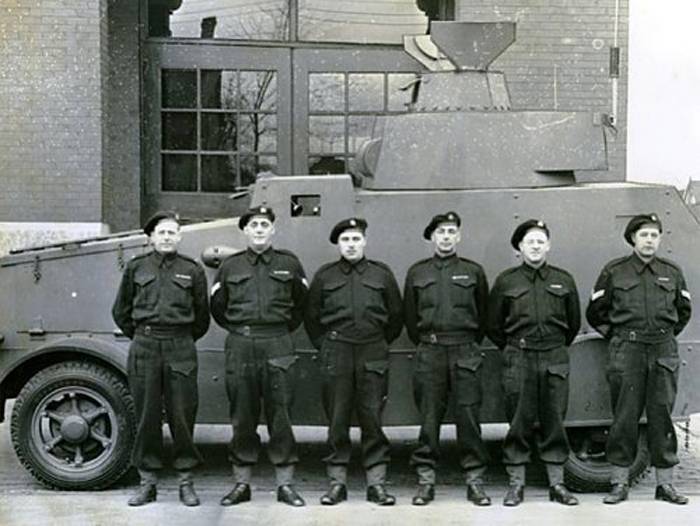
Hamilton Armored Car armored car and its crew. Photo Mapleleafup.net
Fear of possible sabotage, above all, led to a change in the general atmosphere in the city. Now the residents of Hamilton have become wary of any visitors, especially from foreign countries. Every new person, especially an Italian or German, was considered as a potential spy or saboteur. However, the fighters and leaders of HCG soon found a way to protect themselves from enemy scouts. To increase the combat capability of the militias, an army was ordered weaponand besides, there was an offer to build your own armored car.
A wheeled vehicle with armor and the possibility of equipping with small arms was supposed to participate in patrols and guard various objects, and also show the population the readiness of the militia to meet the enemy fully armed. In the shortest time possible to find the construction of a future combat vehicle. Hamilton militiamen were able to develop an original project on their own, and the command and available contacts helped with the search for resources and subcontractors.
As far as is known, the project of the original armored car for the Hamilton Civil Guard did not receive any special name. In the preserved documents of that time, this car appears under different names, while the “official” designation is unknown. Most likely, the Hamilton militia did not pay much attention to this issue. Thus, this sample of equipment can rightfully be called Hamilton Armored Car. Other similar designations also have the right to exist.
To simplify and accelerate the construction of the desired technology, it was decided to use the long-known and tested method. As a basis for the armored vehicle, it was proposed to use the International Chastter’s serial truck chassis. On top of the finished chassis should install the original armored body that meets all the requirements. This approach allowed us to create the desired armored vehicle, but at the same time to do with the forces of only urban enterprises.
The overall assembly of the future armored car was entrusted to Hamilton Bridge. The armor parts were ordered by Dominion Foundries and Steel and Steel Supplied. At a certain point, an order appeared for the production of a tower of the required construction. This product should have been collected by Turnbull Elevators from Toronto. Considering the list of companies involved in construction, it can be assumed that employees of enterprises who served in the militia — future operators of the new armored vehicle — made a significant contribution to the assembly.
The chassis of the International Harvester truck was taken as the basis for the armored car. The exact model of this chassis is unknown, but there is a version about using a D50 machine. It was a commercial two-axle truck with a lifting capacity of up to 4 t. Depending on the modification, it could be equipped with various types of bodies or carry special equipment for one purpose or another. The existing characteristics of the chassis is quite allowed to use it as a base for armored vehicles.
Truck IH D50 was built on the basis of a metal frame and had a bonnet layout with a front engine. A six-cylinder liquid-cooled carburetor engine with an 93,7 hp power was attached to the front of the frame. With the help of a mechanical transmission with five forward speeds and a single rear torque, it was extended to the leading rear axle. A belt drive connected the motor shaft to a 6-volt generator. Also at the heart of the electrical system were the battery and the engine starter.
Like many trucks of that time, D50 had a dependent suspension of both axles with amortization in the form of sheet semi-elliptic springs. 7.50-20 tires were used on all wheels. The front wheels were made odnoskatnymi, rear - dual. All four wheels were equipped with brake pads, hydraulically controlled.
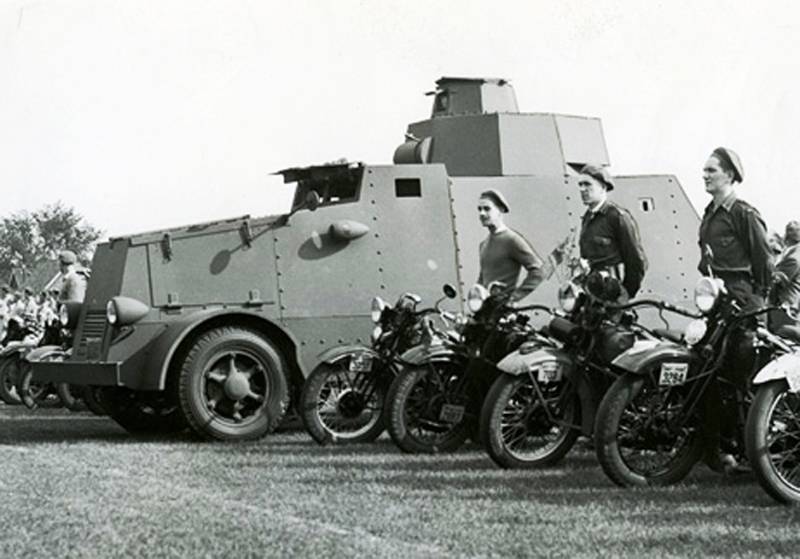
Armored car on ceremonial construction. Photo Shushpanzer-ru.livejournal.com
On the existing chassis, Hamilton enthusiasts decided to mount an original armored body. It should be noted that the exact parameters of such a body remain unknown. According to one data, the car received anti-bullet and fragmentation booking. However, other sources claim that at the time of construction of the Hamilton Armored Car, the enterprises participating in the project did not have time to expand the production of armored steel. Because of this, a protected case could be assembled from an available “soft” metal. From what material the case was actually assembled, and what level of protection it had was not known for certain.
Armored body assembled on the basis of the frame. Separate sheets of relatively simple forms were fastened to it with rivets. The resulting body consisted of two separate compartments of different sizes and was made on the hood layout, corresponding to the appearance of the existing chassis. As a result, the front part of the case was noticeably smaller than other units.
The engine was covered with an angular design of sufficient size. The engine compartment received a sloping frontal sheet, in the lower part of which there was a window with a movable flap for air supply to the engine. Boards consisted of two parts. The bottom part was placed vertically, while the top was installed with a blockage inside. At the same time, the sides of the hood diverged in different directions. The roof of the engine compartment consisted of two hinged parts and was installed with a slope forward. To service the engine in the sides there were a couple of large hatches with movable covers.
Directly behind the engine located a kind of department of management. In this part of the hull, the beads continued to diverge, forming a structure of sufficient width. In addition, the upper sloped parts of the compartment had a raised rear part. A small inclined front sheet was connected to the roof of the engine compartment with inspection hatches.
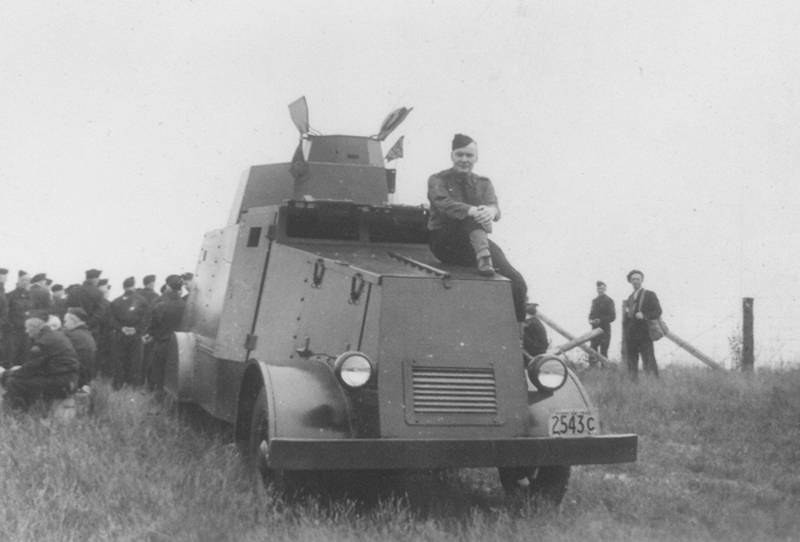
Front view. Photo Shushpanzer-ru.livejournal.com
Behind the driver and his assistant there was a fighting compartment, which received the protection of a similar design. It had a tilted side of a reduced height, connected to a horizontal roof. The lower part of the sides was complemented by protruding semicircular wheel covers. Behind the inner volume was covered by the stern, consisting of a large inclined top sheet and a narrow vertical bottom.
The Hamolton Armored Car armored car received an original turret, resembling the aggregates of some serial combat vehicles. In pursuit of the roof of the hull, a polygonal unit was placed, which had a narrow vertical frontal sheet and large cheekbones. A curious feature of the tower was the presence of a sufficiently large aft niche. In front of the horizontal roof was placed a polygonal commander's turret with viewing slots, the roof of which was made in the form of a hatch with two covers. As follows from the available data, the main tower and the turret on it could freely rotate in any direction.
Access to the habitable compartment was provided by a large rectangular door in the feed sheet. The second door of a smaller size was in the right side, immediately behind the driver and his assistant. In addition, with a certain skill, the car could get through the hatch commander's turret. The driver and his assistant could follow the road with a pair of inspection hatches in the front sheet, which were covered with guards in a combat situation. Another pair of hatches was in the sides of the "cabin". The sides of the fighting compartment also had one hatch, which could also be used as an embrasure.
The HCG armored car could be equipped with its own small arms. For its use in the front sheet of the tower there was an embrasure, possibly equipped with fastenings of a particular design. By turning the turret and swinging the weapon, it was possible to fire at targets in any direction at different elevation angles. Nevertheless, despite this design of the weapons installation, the real combat capabilities of the armored car left much to be desired.
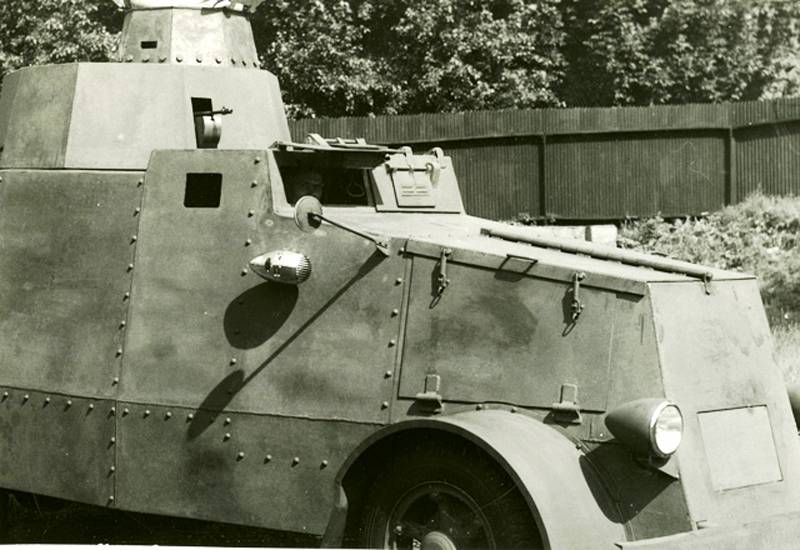
View of the starboard. Photo Shushpanzer-ru.livejournal.com
For well-known reasons, the people's militia at that time could not count on receiving a large number of weapons with high performance. So, in the summer of 1940, only rifles, shotguns and several Thompson submachine guns were handed over to the Hamilton militia. One of the latter was mounted in the tower of an armored car. Using the embrasure for shooting and searching for targets, the shooter could attack the enemy with very limited effectiveness. Ammunition storage facilities were placed next to the weapon in the fighting compartment. Under certain circumstances, the rifles of the crew or the assault force could become an additional weapon of the armored car.
The own crew of a Hamilton Armored Car armored car was to consist of several people: the driver, his assistant, the commander and the gunners. The driver with the assistant were in front of the habitable compartment, the commander and the arrows were in the fighting compartment. If necessary, the car could take on board a sufficiently large number of people, helped by the size of the original case. Thus, under certain conditions, the armored car could also become an armored personnel carrier.
The car was equipped with its own radio station. This device was primarily intended to communicate with the police of the city. Thus, if necessary, the police could call the militia to the scene of the incident, and jointly overcome the threat.
The total length of the resulting armored car reached 6 m, width - about 2 m, height - more than 2,5 m. The combat weight approached 5 tons, which, in general, corresponded to the characteristics of the base chassis. Specific power over 18,7 hp per ton yielded acceptable mobility. It is reported that during the service the armored car was able to show speeds up to 60 miles per hour (96 km / h). Power reserve - a few hundred kilometers. It can be assumed that the armored car could show sufficiently high road performance only on a good road.
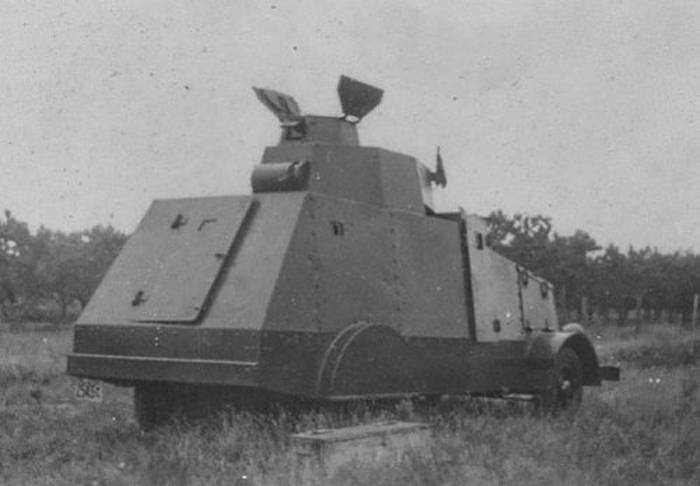
Feed cars. You can consider the original design of the tower. Photo Mapleleafup.net
Despite a certain complexity, the construction of an armored car for the Hamilton Civil Guard did not take long. The construction of the first car of the new type ended in August 1940. Then tests were carried out, and in the twenties the car was put into operation.
It is curious that initially the command of the Hamilton militia planned to build three armored vehicles of a new type, but it was soon abandoned. Due to a number of specific factors, to some extent related to the design and construction, the first armored vehicle of its own design cost the city administration 6527 Canadian dollars. For comparison, the real factory armored carrier Universal Carrier at that time was worth about 3 thousand dollars. Thus, the assembly of the two following armored cars allowed to increase the combat capability of the troops, but it turned out to be unacceptably expensive. As a result, only one armored car was built.
The transfer of the armored car to the operators ended in a curious incident. In accordance with the plans, the car had to be on duty in the garage of the city police department. Armored car Hamilton Armored Car drove to the place of service, and immediately found out that it simply does not pass through the garage door. Fortunately, he was soon found a new place of duty - the fire department, the garage of which was designed for tall cars with stairs. There the armored car entered without problems.
As is known, German and Italian saboteurs never reached Canada in general and Hamilton in particular. Therefore, the only armored car built by local militiamen on its own project did not get an opportunity to take part in real combat operations. He remained in the garage of the fire station, from time to time leaving for certain activities: to conduct patrols or participate in exercises. For obvious reasons, no one thought to send this car outside the country for use in real battles on existing fronts.
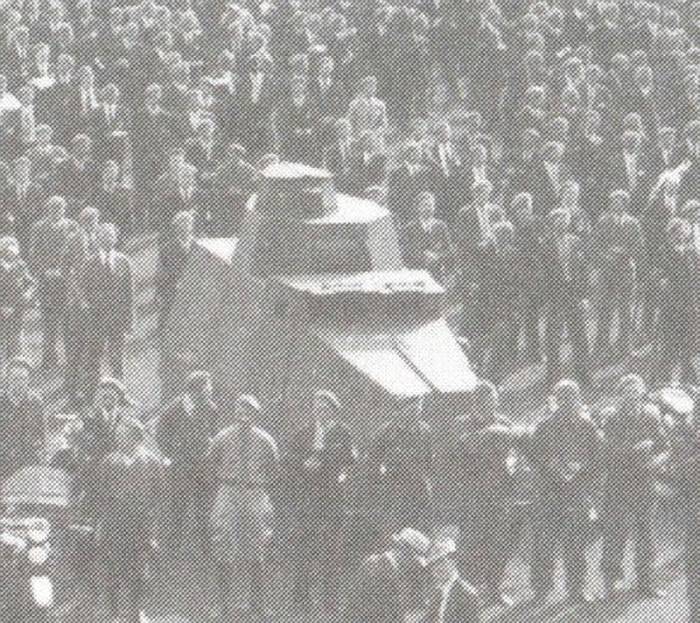
Hamilton armored car surrounded by militias and local residents. Photo Mapleleafup.net
Already during the operation of the machine has undergone some modifications. So, the front cover hatch lost the movable cover and received horizontal blinds, simplifying the air supply to the radiator. Some other details were also improved. The rest of the design remains the same. In particular, the armored vehicle retained its absurdly weak weaponry, since the militia did not have access to more serious systems.
Over the next five years, the HCG fighters regularly used the existing Hamilton Armored Car armored car in various events. In between terrain patrols, exercises and training were conducted, during which combat training tasks were accomplished with the most active participation of the armored car and its crew. Even with very limited technical and combat characteristics, this vehicle had a positive effect on the combat capability of the militia as a whole. Naturally, the capabilities of the detachment and its equipment were tested only at the test sites, but not in real battles.
After the end of the war in 1945, the only armored car of the local militia was decided to write off as useless. Immediately there was a dispute about the future of the car. The chassis of the D50 truck has not yet managed to work out its resource and therefore could be used in the original quality. It was only necessary to remove the existing armored hull and carry out some repairs. This truck wanted to get at their disposal the police and fire brigade. The third side of this "conflict" was the structure of the HCG. All participants in the dispute tried to convince opponents of the need to transfer the car to them. In addition, attempts were made to influence the city administration.
Who exactly got the demounted chassis is unknown. Similar story did not keep accurate information about the career of a single Hamilton Armored Car. It is only known that no later than the end of 1945, this car ceased to exist in the configuration of an armored car. Apparently, the hull was removed and sent to the smelter, and the chassis found a new owner. To whom it served in the future and how many years remained in operation - it remains only to guess.
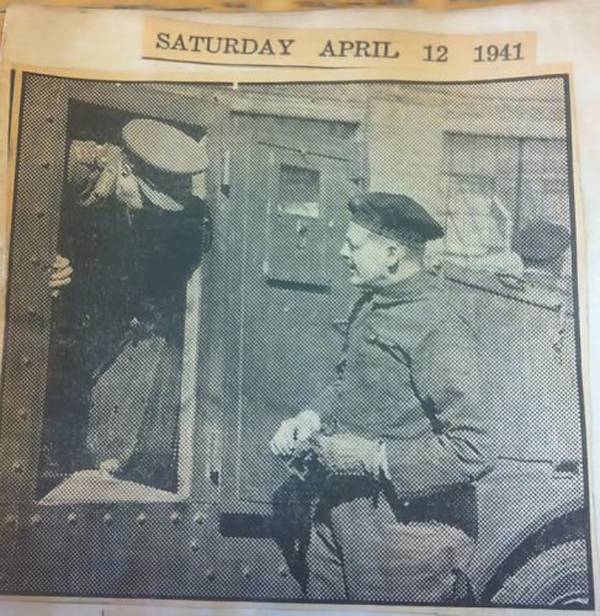
The armored vehicle became the hero of publications in the local press. Photo Mapleleafup.net
It is hardly necessary to clarify that in the existing configuration the armored car of the national militia of Hamilton could hardly be a full-fledged combat vehicle. Indeed, the amateur project was based on morally obsolete ideas and solutions that facilitated the development and assembly, but did not give any other advantages, primarily of a combat nature. In addition, resource constraints could lead to noticeable problems. So, according to some information, the Hamilton Armored Car hull was built not from armor, but from structural steel. The fact of arming a large armored car with just one submachine gun, even if it is a rather large caliber, can be classified as curiosity.
Fortunately for the authors of the original project and the operators of the new technology, the armored car for the Hamilton Civil Guard squadron was used only in its hometown and at a great distance from the theaters of the Second World War. Thanks to this, the car never came under fire, and its crew did not risk their health or life. At the same time, the only armored car allowed to a certain extent to strengthen the militia and the police.
Bearing in mind the main features of the original armored car and its not the most difficult "combat path", it should be noted that he still managed to cope with its main tasks. Despite the good geographical position of their country, Canadians feared possible events directly related to the war in other parts of the world. The armored car, built according to a handicraft project, made it possible to show people the readiness to fight for their country and instill confidence in them.
On the materials of the sites:
https://thestar.com/
http://mapleleafup.net/
http://content.wisconsinhistory.org/
http://shushpanzer-ru.livejournal.com/
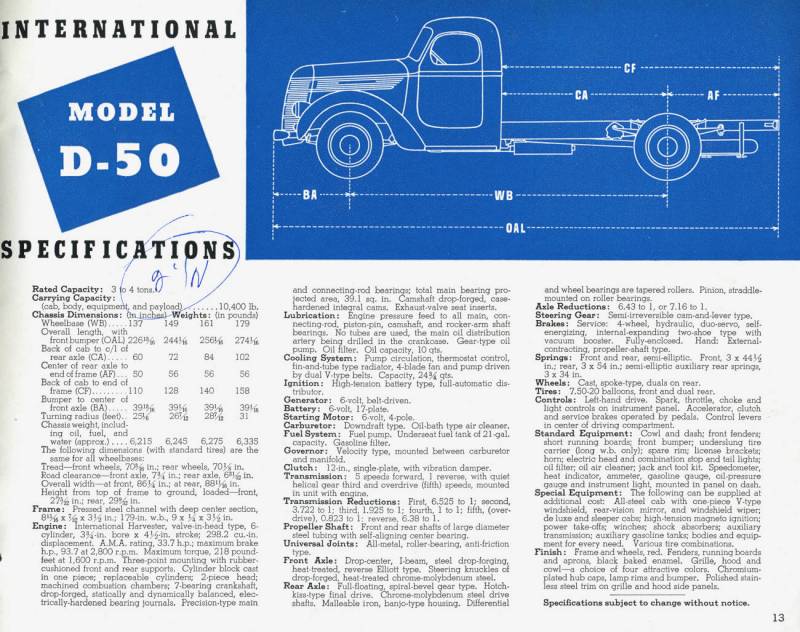
Information